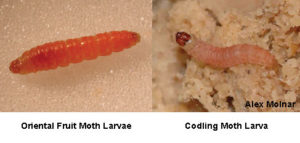POP encourages all orchard partners and backyard fruit growers to take every step in orchard management prior to pesticide or fungicide application. However, the unfortunate reality is that ecosystem imbalances and fast rates of reproduction and adaptation among pests and diseases make it very difficult to maintain no-spray orchards. If the following pests are decimating your crops, Spinosad is a recent natural pesticide development and alternative to Bt, which may be worth carefully exploring.
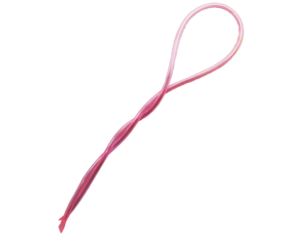
According to Dow AgroSciences, spinosad can be effective when facing serious issues with codling moth, oriental fruit moth, leafrollers, peach twig borer, spotted wing drosophila, cherry fruit fly, leaf miner, pear psylla, some thrips, plum curculio, apple maggot, and many others. Spinosad is generally not effective for control of sucking insects such as aphids, whiteflies, most thrips, scale, mites, or true bugs (stink bugs, spittle bugs, mealy bugs, lygus bugs, harlequin bugs, cabbage bugs, cicadas, leaf hoppers, tree hoppers, blue sharpshooters, etc).
Spinosad Introduction
Spinosad is a natural substance made by a soil bacterium species, Saccharopolyspora spinosa, which was discovered from soil in an abandoned Caribbean rum distillery in 1982 and has been registered for use in pesticides by the US Environmental Protection Agency (EPA) since 1997. It is reported to have a longer period of residual effectiveness compared with Bt, up to seven days, and also to be economical and effective at extremely low rates (1.5-4.5 ounces/acre).
Generally, Spinosad is effective against insect larvae while they are on the surface of your plants and before they enter your crop, so it is important to track the life-cycle of your pests and to spray at the appropriate time. Insecticidal control should be directed toward young larvae that are feeding on the exposed parts of plants. Monitoring your orchard closely to identify when to spray is crucial, and including pheromone traps into your pest management strategy could help you time your sprays!
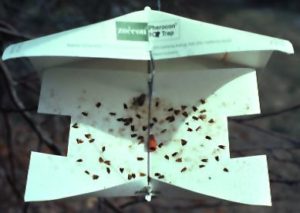
Caution for Pollinators!
While spinosad is not as broad-spectrum nor as long-lasting as many synthetic insecticides, it can kill bees and other beneficial insects. Spinosad affects the nervous system of insects that eat or touch it and is toxic to pollinators when wet; do not apply while pollinators are actively foraging! Conclusions from studies, however, report spinosad residues that have been allowed to dry for 3 hours are not acutely harmful to honeybees when low-volume and ultralow-volume sprays are used.
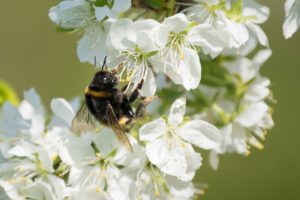
Early morning or late-day applications before or after pollinator activity has subsided on clear nights will better expose targeted insects to the toxins and protect pollinators if choosing to apply spinosad. One also might consider not spraying tree’s in bloom, as pollen and nectar from sprayed plants may have transient effects on brood development in honey and bumblebees.
Spinosad has been reported to have very low toxicity to mammals, birds, and many aquatic invertebrates, while it is moderately to slightly toxic to fish and highly toxic to marine shellfish. In the environment, its solubility is low above a pH of 5, and if it is binding to soil particles and breaking down from sunlight and soil microbes under typical aerobic conditions; it would be unlikely to leach into groundwater.
Chemical Information and Spinosad in the Environment
According to the National Pesticide Information Center, Spinosad is broken down rapidly by sunlight, with a half-life on leaves in sunlight being 2 to 16 days and less than one day in water with sunlight. In the absence of sunlight, spinosad breaks down very slowly in water with a half-life of 30 days to 259 days. Spinosad binds rapidly to sediment, and in top layers of soil that are aerobic, spinosad is rapidly broken down by microbes with a half-life of 9 to 17 days. In sediment with no oxygen, also known as anaerobic soil conditions, Spinosad is reported to have a half-life of 161-250 days. After it is applied, spinosad is not likely to become airborne.
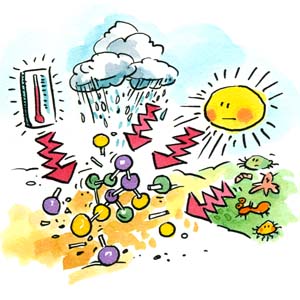
Because of Spinosad’s environmental safety profile, most states in the US do not require posting of pesticide warnings after spinosad applications, and spinosad only has a 4-hour reentry interval (REI) for worker protection with a one day-to-harvest (dh) restriction. The Organic Materials Review Institute currently lists 21 approved spinosad products. As always, you can limit your exposure and reduce risk by carefully following the label instructions.
Products
Currently, spinosad is found in over 80 registered pesticide products, of which some are approved for use in organic agriculture. These products come as sprays, dusts, granules, and pellets. A few commonly used products in orchards include Entrust, Captain Jack’s Deadbug Brew. , and Monterey Garden Insect Spray. One place you can find more information about organic pesticide products is here, and also search for products is here
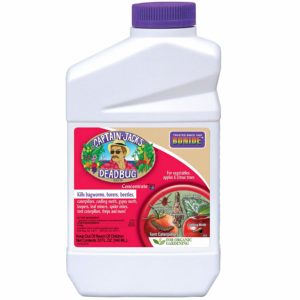
Resources
http://www.wegmansnursery.com/care-guides/general-information/spinosad.html
https://www.planetnatural.com/product/monterey-garden-insect-spray-spinosad/
https://www.motherearthnews.com/organic-gardening/pest-control/spinosad-zmgz11zrog
http://npic.orst.edu/factsheets/spinosadgen.html
http://agreport.bz/spinosad-an-alternative-to-chemical-pesticidesinsecticides/
https://www.ncbi.nlm.nih.gov/pubmed/15366583
https://oehha.ca.gov/media/downloads/pesticides/fact-sheet/hqaentrust2015.pdf
http://livingwebfarms.org/wp-content/uploads/2016/03/Practical-Orchard-Health-seasonal.pdf
http://www.cdms.net/ldat/ld62B024.pdf
https://www.biconet.com/botanicals/infosheets/MontereySprayLabel.pdf
This POP Blog Post was written by POP Orchard Director Michael Muehlbauer.
SUPPORT US! If you found this entry useful, informative, or inspiring, please consider a donation of any size to help POP in planting and supporting community orchards in Philadelphia: phillyorchards.org/donate.
